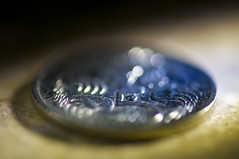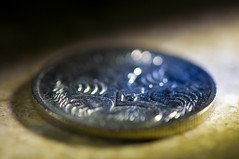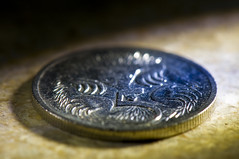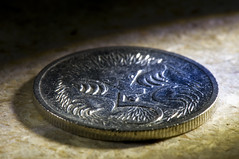Depth of field
See also Lens: Depth of field
In the abstract
Depth of field is a measure of the zone of distances (from near to far) that are within acceptable sharpness at a given aperture and focus distance. "Acceptable" sharpness is subjective and becomes more critical for larger prints or projection.
When a lens is focused on a subject at a given distance, all subjects at that distance are sharply focused. In theory, subjects that are not at the same distance are out of focus, and thus not sharp. However, since human eyes cannot distinguish very small degree of unsharpness, some subjects that are in front of and behind the sharply focused subjects may still appear to be sharp. This zone of acceptable sharpness is referred to as the depth of field. Thus, increasing the depth of field increases the perceived sharpness of an image. Using smaller apertures or larger distances increases the depth of field.
Depth of field extends further behind the plane of focus than in front and the difference increases with distance. This means that infinity can be brought into approximate focus far more easily than objects closer than the subject.
Depth of field is proportional to distance from the lens optical centre to the subject, not film plane to subject. This explains why depth of field reduces dramatically when the subject is very close, since subject distance from the optical centre has reduced proportionally more than overall distance. At long distances the small difference between film plane and optical centre is insignificant.
As aperture is reduced depth of field increases, however diffraction then decreases overall sharpness. Most lenses render highest sharpness at one or two stops less than their maximum aperture; much smaller apertures usually reduce both sharpness and contrast as diffraction degrades the image.
Depth of field has nothing to do with lens construction: it is a purely geometric property. Whether zoom or prime (fixed) lens, regardless of how many elements, whether wide angle or telephoto, depth of field is the same for a given f stop and magnification at the film plane or image sensor. Depth of field is commonly thought to be related to focal length, but is actually related to magnification. Changing to a longer focal length or moving closer to the subject both have the same effect of increasing magnification and reducing depth of field.
A lens with poor resolution may appear to have greater depth of field but this is simply due to none of the picture being truly sharp. Low cost cameras with fixed focus lenses take advantage of this effect.
In practice
For obvious reasons, depth of field is an aspect of photography that photographers want precise control over. In portrait photography, a shallow depth of field is often used to isolate the subject from the background. A three-quarters or head-and-shoulder portrait with bokeh for a backdrop is something of a cliche in professional photography. The standard practice is to use a medium-length lens to allow a very shallow depth of field and a narrow field of view at a medium distance; the distance between the camera and the subject helps avoid "nose distortion," in which parts of the body that are too close to the lens appear enlarged. Many amateur portrait-takers find that their subject appears to have a large and bulbous nose due to this effect. The fact that this effect in the realm of selfie photography is driving many young people to have cosmetic surgery is deeply regrettable.
Meanwhile, and on a more strictly relevant note, in landscape photography and other applications, it is often desirable to focus on both the background (at or near infinity) and some object of interest in the near or middle field; this requires a deep depth of field. The nature of landscape photography in particular is amenable to slow shutter speeds (since a tripod can be used) and thus smaller apertures and deeper fields. Wide lenses are often used in landscape photography. Aside from the obvious reason that a wide lens takes in more of the landscape, it is also advantageous that wider lenses have lower magnification and thus greater depth of field at a given aperture.
The fact that the far field extends much further out than the near field extends inward of the subject can be used to the photographer's advantage using a technique known as hyperfocus. This is where the photographer focuses on a point (the "hyperfocal point") closer than infinity, but chooses an aperture so that the far field then reaches to infinity. This maximizes the near field while keeping infinity in focus. An example with a 35mm lens, often used in street photography, is this: the photographer sets the aperture to f/8, a workable aperture with a good compromise between image quality and depth of field. The photographer focuses to 20 feet and then leaves the focus and aperture settings where they are, knowing that all objects between approx. 8 feet and infinity will be in focus. This is the meaning behind the sensational news photographer "Weegee" Fellig's famous catchphrase: "F/8 and be there." He was noted for never changing the focus or aperture on his Speed Graphic from 10ft and f/8, instead relying on hyperfocus.
Because it is so important in so many contexts, most cameras above a certain level of complexity have some way for the photographer to determine the depth of field. Most standard and higher-end SLR prime lenses have what is known as a "Depth of Field scale" or "Depth of Field calculator," in which the focus ring and the fixed body of the lens each have a precisely calculated scale printed on them. One scale has various distances, often in both meters and feet. Due to the nature of lenses, this is normally not a linear progression, but roughly exponential, i.e., the distance between one and two meters on the scale is normally smaller than the distance between two and three meters, and so on. The second scale has a mark for the absolute point of focus (i.e., the distance at which the lens is truly, actually in sharp focus), and on either side of this mark, two marks for each f-stop (or each f-stop above, say, f/4, if the lens has a shallow depth of field). The range of distances on the first scale that fall between the marks for a given f-stop will be in acceptable focus at that f-stop. Some cameras have a radically different way of presenting this information, such as the Kodak Medalist which has a rotary calculator synchronized with the lens, located on top of the camera body,
Most film and some digital SLR's also have a way to preview the depth of field directly, by stopping down the diaphragm to the selected f-stop. This allows the photographer to see the area that is in focus exactly as the film/sensor will see it. Additionally, many rangefinders and TLR's have scales to calculate depth-of-field on the lens or focusing mechanism, but in some lower-end cameras the scale is imprecise. In some cases, a surprisingly high-end camera or lens will lack a scale altogether, as in the case of the Canonet QL17 GIII and most SLR zoom lenses.
Some cameras with autofocus and autoexposure, such as the original Canon EOS and its successors, have a "Depth of Field Priority" mode, in which the photographer selects two objects or zones of focus using the viewfinder, and the camera sets shutter speed, aperture and focus so that the picture will have exactly the selected depth of field.
|
|
|
| ||||||||
|
Effects of increasing Depth of Field | |||||||||||
Links
- "Depth of field" at Wikipediia
- Depth of field explained by Dr. Ching-Kuang Shene
- Online depth-of-field calculator from DOFMaster.com
- More online calculators for hyperfocal distance and DOF, from John Hendry
- "Depth of Field and Bokeh" (archived) by Dr. Hubert Nasse, a white paper from Carl Zeiss at Zeiss Global



